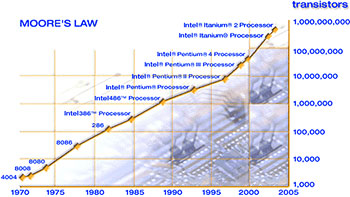New materials have been developed with the aim of further reducing the transistors in the computer and breaking the frontier of nanotechnology. In this way, these technologies extend the era of silicon as the basis of the computing industry
Avi Blizovsky
 Image - the graph of Moore's law, from the Intel website -
Image - the graph of Moore's law, from the Intel website -
Intel announced that it will start developing a production process where the transistors will be 45 nanometers wide (a billionth of a meter). Shrinking the basic building blocks of chips will allow them to be built faster and more efficiently. IBM also signaled this week its intentions to start manufacturing chips that use these tiny components. The blue giant, which developed its transistor technology together with Toshiba, Sony and AMD, intends to integrate these components into chips in 2008. Intel said it will begin commercial production of the processors at three of its plants later this year.
Intel's new processors, whose code name is Penryn, will contain 400 million transistors on a chip that is about half the size of a postage stamp. Like the current processors they will come in a dual core and quad core package and this means that there will be two or four separate processors on each chip. The company did not say what the speed of the system would be.
The production technology at 45 nanometers has been the goal for chip manufacturers since they managed to achieve the previous record - 65 nanometers. A transistor is a basic electronic switch. Each chip requires a large number of transistors and the more there are and the faster they are able to switch, the greater the chip's power measured in the number of calculations it is able to perform per unit of time.
The meaning of the development is that the basic law that characterizes the chip development process, known as "Moore's Law", remains the same. The assumption of one of the co-founders of Intel, Gordon Moore from 1965, was that the number of transistors on a chip would double every 24 months. Moore's law presents a development forecast for the processor and computer industry and on the other hand it also serves as a kind of road map for the industry itself. The fear of the companies in the field of processors and computers is to be left behind and their motivation to continue developing technology at a fast pace is great.
For over 45 years, chip manufacturers have managed to keep up with the pace that Moore predicted (literally a self-fulfilling prophecy), reducing the size of chips while packing far more chips into each chip. However, after crossing the 65 nanometer limit, the silicon used to manufacture essential components of the chips - non-conductive gates - were no longer able to reach the performance reached by their predecessors on a larger scale. As a result, the current passes through the holes in the transistors and reduces the capacitance of the chip. To prevent this, the researchers had to develop new materials that would contain the current on such a small scale. The type of silicon derivative known as high-k metals.
The development and integration of the new materials into working components was described by Gordon Moore (age 78) as the biggest change in transistor technology since the late sixties. The first operational chips to incorporate 45-nanometer components were introduced last year by Intel, but they have not yet been incorporated into commercial products.
Dr. Che Xiang Chen, Vice President of Science and Technology at IBM Research Laboratories said: "Until now, the chip industry has faced the question mark of how far they can push the current chip technology. After 10 years of effort, we are now making progress."
The two manufacturers did not say exactly how they incorporate these metals, but both Intel and IBM said they were able to integrate these chips into their current manufacturing technology with minimal effort.

2 תגובות
Misspelling "the present"
Correction to the article:
Intel started developing the aforementioned production process more than a year ago and the processor in question (penryn) already has hundreds of prototypes that run all the operating systems on the market.
The processor will be released in the fourth quarter of 2007.